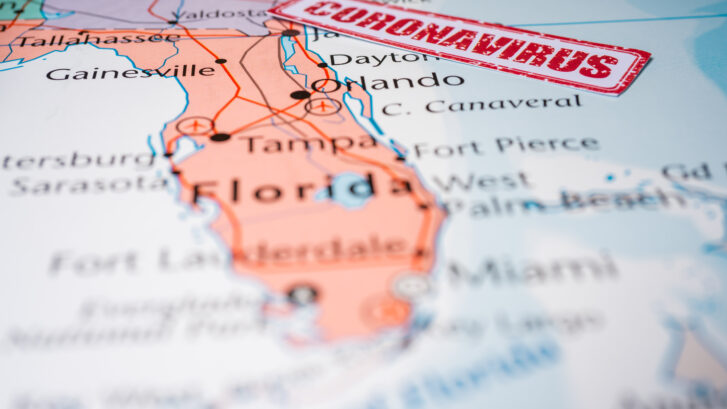Masks, Kids, and COVID-19
Is your head spinning from all the conflicting guidance on masks for adults as well as children? You’re not alone. So let our concierge primary care doctors try to clear up some of the confusion on masks, kids and COVID-19.
Easier to catch
The most important point is that the delta variant of the coronavirus is proving to be far more transmissible than the original virus and its other variants.
Remember that each time the virus mutates, it can gain some type of advantage over earlier variants. It may learn how to spread more quickly, or how to evade antibodies built up in the body, whether from previous infection or a vaccine.
This is what has been happening with the coronavirus. The original version was dangerous and deadly. Then it mutated into the alpha version—the one that predominated in the U.S. last year. It caused even more illness and deaths than alpha.
“Delta is alpha on steroids,” James M. Musser, chair of the Department of Pathology and Genomic Medicine at Houston Methodist Hospital and Research Institute, told The Washington Post recently.
That’s because the viral load from delta is 1,000 times higher than the original virus. And it’s ten times higher than the alpha variant. Now it accounts for more than 83 percent of COVID-19 cases, according to the Centers for Disease Control and Prevention (CDC).
Changing guidance
That’s the reason the American Academy of Pediatrics (AAP) early last month recommended all kids in school wear masks. They maintain this even if they’re fully vaccinated against COVID-19.
Their guidance went further than that of the CDC. In May, the CDC recommended those fully vaccinated (i.e., two shots of the mRNA vaccines or one of the Johnson & Johnson vaccine) could safely go without masks indoors two weeks after their last injection.
Then late last month, the CDC reversed its May guidance. It now says everyone should wear masks indoors in areas “with substantial and high transmission,” even if they’ve been vaccinated. That would include Florida, which has seen its caseload soar in recent weeks.
The Miami Herald reports that our state has entered a peak of COVID-19 cases not seen since January’s surge. Late last month Florida accounted for about 20 percent of new COVID-19 cases across the United States. The seven-day positivity rate here was a whopping 17.21 percent. (Five percent or lower is considered low transmission.)
The CDC now agrees with the AAP. They both recommend everyone in K-12 schools wear a mask even if they’ve been vaccinated.
In announcing its decision, the agency cited preliminary research. This found those who have been vaccinated and become infected, even if they’re asymptomatic, show viral loads in tests as high as those who haven’t been vaccinated. While not definitive, they decided the evidence was compelling enough to reinstate the mask recommendation.
Targeting more children
In addition to spreading more easily, the COVID also seems to be infecting more kids than earlier variants. According to the AAP, more than four million children have been diagnosed with COVID-19. Kids represent about 14 percent of all cases to date. In just the last two weeks of July, 38,654 children became infected.
“This variant is spreading like wildfire,” Jim Versalovic, pathologist-in-chief and interim pediatrician-in-chief at Texas Children’s Hospital, told NBC News.
“That means that we have to be extra careful among those who are unvaccinated and partially vaccinated. We’re very concerned about children under 12 who have no access to the vaccine right now.”
Children at risk
CDC Director Rochelle Walensky compared the effects of COVID-19 in kids to the flu.
“If you look at the mortality rate of COVID just this past year for children, it’s more than twice the mortality rate we see in influenza in a given year,” she told CNN recently.
And even if children in most cases have milder symptoms, they can still suffer long-term effects.
“We don’t know the consequences of long-haul COVID in children and younger people,” Dr. Peter Hotez, Dean of the National School of Tropical Medicine and Professor of Pediatrics and Molecular Virology & Microbiology at Baylor College of Medicine, warned on MSNBC.
Finally, any single person of any age who gets COVID-19 is giving the virus a chance to mutate. That concerns Walensky, who warned that the virus could be “just a few mutations away” from being able to evade the vaccines. This would put us right back where we were last year.
Not out of the woods
Dr. Aileen Marty, an infectious disease expert at Florida Atlantic University advises Miami-Dade County leaders on the pandemic. She told CNN she’s not surprised the virus has increased in her state and across the country.
“In every case, we keep jumping the gun and behaving as if the pandemic’s over because case numbers are going down,” she said. “And that allows the virus to once again take the upper hand.”
Dr. Francis Collins, director of the National Institutes of Health (NIH), told MSNBC that masks will help until the expected emergency use authorization (EUA) for children under 12 this fall or winter.
“The virus doesn’t care that we’re sick of masks,” he said. “The virus is having another version of its wonderful party for itself. And to the degree that we can squash that by doing something that maybe is a little uncomfortable, a little inconvenient . . . if it looks like it’s going to help, put the mask back on for a while.”

